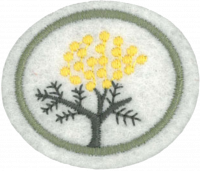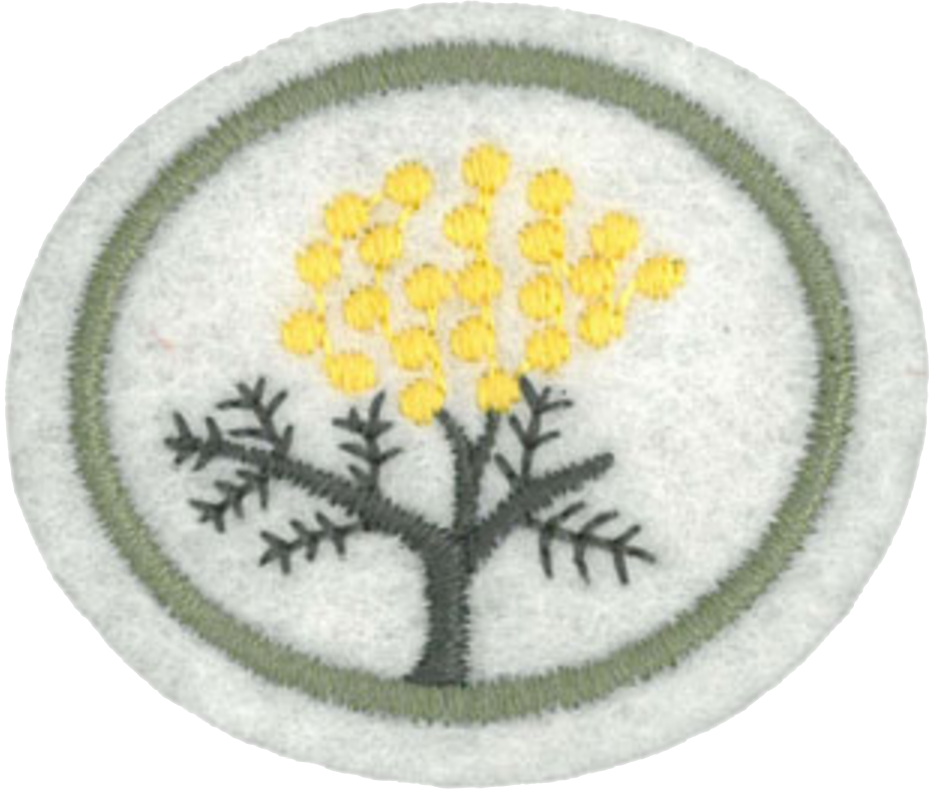Difference between revisions of "AY Honors/Wattles/Answer Key/es"
From Pathfinder Wiki
(Created page with "</noinclude> ==Referencias== Category:Adventist Youth Honors Answer Book/es <noinclude>") |
|||
| (9 intermediate revisions by the same user not shown) | |||
| Line 9: | Line 9: | ||
{{CloseReq}} <!-- 1 --> | {{CloseReq}} <!-- 1 --> | ||
{{ansreq|page={{#titleparts:{{PAGENAME}}|2|1}}|num=2}} | {{ansreq|page={{#titleparts:{{PAGENAME}}|2|1}}|num=2}} | ||
| − | <noinclude> | + | <noinclude></noinclude> |
| − | </noinclude> | + | <!-- 2. ¿Cuáles son los peciolos? ¿Qué trabajo hacen para la planta? ¿Por qué son importantes los peciolos en el estudio de las acacias? --> |
| − | <!-- 2. | ||
| − | |||
| − | |||
| − | |||
{{clear}} | {{clear}} | ||
| Line 27: | Line 23: | ||
{{CloseReq}} <!-- 2 --> | {{CloseReq}} <!-- 2 --> | ||
{{ansreq|page={{#titleparts:{{PAGENAME}}|2|1}}|num=3}} | {{ansreq|page={{#titleparts:{{PAGENAME}}|2|1}}|num=3}} | ||
| − | <noinclude> | + | <noinclude></noinclude> |
| − | </noinclude> | + | <!-- 3. ¿Cómo son clasificadas las acacias en dos grandes grupos? --> |
| − | <!-- 3. | ||
| − | |||
| − | |||
| − | |||
| − | |||
| − | |||
| − | |||
| − | |||
| − | |||
{{clear}} | {{clear}} | ||
| Line 46: | Line 33: | ||
{{CloseReq}} <!-- 3 --> | {{CloseReq}} <!-- 3 --> | ||
{{ansreq|page={{#titleparts:{{PAGENAME}}|2|1}}|num=4}} | {{ansreq|page={{#titleparts:{{PAGENAME}}|2|1}}|num=4}} | ||
| − | <noinclude> | + | <noinclude></noinclude> |
| − | </noinclude> | + | <!-- 4. ¿Cómo la forma de la vaina de la semilla y la forma en que las semillas se encuentran en la almohadilla ayuda en la identificación? --> |
| − | <!-- 4. | ||
| − | |||
| − | |||
{{clear}} | {{clear}} | ||
| Line 57: | Line 41: | ||
{{CloseReq}} <!-- 4 --> | {{CloseReq}} <!-- 4 --> | ||
{{ansreq|page={{#titleparts:{{PAGENAME}}|2|1}}|num=5}} | {{ansreq|page={{#titleparts:{{PAGENAME}}|2|1}}|num=5}} | ||
| − | <noinclude> | + | <noinclude></noinclude> |
| − | </noinclude> | + | <!-- 5. ¿Cuántas acacias en su estado tienen hojas verdaderas (pinnado) cuando son adultas? --> |
| − | <!-- 5. | ||
| − | |||
| − | |||
| − | |||
{{clear}} | {{clear}} | ||
| Line 69: | Line 49: | ||
{{CloseReq}} <!-- 5 --> | {{CloseReq}} <!-- 5 --> | ||
{{ansreq|page={{#titleparts:{{PAGENAME}}|2|1}}|num=6}} | {{ansreq|page={{#titleparts:{{PAGENAME}}|2|1}}|num=6}} | ||
| − | <noinclude> | + | <noinclude></noinclude> |
| − | </noinclude> | + | <!-- 6. En la siembra de acacias, ¿qué es lo que se ve in primer lugar, hojas verdaderas o peciolos? ¿Cuántos tienen hojas verdaderas? --> |
| − | <!-- 6. | ||
| − | |||
| − | |||
{{clear}} | {{clear}} | ||
| Line 80: | Line 57: | ||
{{CloseReq}} <!-- 6 --> | {{CloseReq}} <!-- 6 --> | ||
{{ansreq|page={{#titleparts:{{PAGENAME}}|2|1}}|num=7}} | {{ansreq|page={{#titleparts:{{PAGENAME}}|2|1}}|num=7}} | ||
| − | <noinclude> | + | <noinclude></noinclude> |
| − | </noinclude> | + | <!-- 7. ¿Qué debe ocurrir a una semilla de acacia antes de que germine y crezca? --> |
| − | <!-- 7. | ||
| − | |||
| − | |||
<noinclude></noinclude> | <noinclude></noinclude> | ||
{{CloseReq}} <!-- 7 --> | {{CloseReq}} <!-- 7 --> | ||
{{ansreq|page={{#titleparts:{{PAGENAME}}|2|1}}|num=8}} | {{ansreq|page={{#titleparts:{{PAGENAME}}|2|1}}|num=8}} | ||
| − | <noinclude> | + | <noinclude></noinclude> |
| − | </noinclude> | + | <!-- 8. ¿Cuáles peciolos de las acacias son usados para guardar alimento en tiempos de sequía? --> |
| − | <!-- 8. | ||
| − | |||
| − | |||
{{clear}} | {{clear}} | ||
| Line 102: | Line 73: | ||
{{CloseReq}} <!-- 8 --> | {{CloseReq}} <!-- 8 --> | ||
{{ansreq|page={{#titleparts:{{PAGENAME}}|2|1}}|num=9}} | {{ansreq|page={{#titleparts:{{PAGENAME}}|2|1}}|num=9}} | ||
| − | <noinclude> | + | <noinclude></noinclude> |
| − | </noinclude> | + | <!-- 9. ¿Cómo es la corteza de algunas acacias utilizado en Australia? --> |
| − | <!-- 9. | ||
| − | |||
| − | |||
<noinclude></noinclude> | <noinclude></noinclude> | ||
{{CloseReq}} <!-- 9 --> | {{CloseReq}} <!-- 9 --> | ||
{{ansreq|page={{#titleparts:{{PAGENAME}}|2|1}}|num=10}} | {{ansreq|page={{#titleparts:{{PAGENAME}}|2|1}}|num=10}} | ||
| − | <noinclude> | + | <noinclude></noinclude> |
| − | </noinclude> | + | <!-- 10. ¿Qué especies de acacias se utilizan para hacer muebles? --> |
| − | <!-- 10. | ||
| − | |||
| − | |||
<noinclude></noinclude> | <noinclude></noinclude> | ||
{{CloseReq}} <!-- 10 --> | {{CloseReq}} <!-- 10 --> | ||
{{ansreq|page={{#titleparts:{{PAGENAME}}|2|1}}|num=11}} | {{ansreq|page={{#titleparts:{{PAGENAME}}|2|1}}|num=11}} | ||
| − | <noinclude> | + | <noinclude></noinclude> |
| − | </noinclude> | + | <!-- 11. ¿Cómo las acacias ayudan y benefician al hombre, los animales, los insectos, y las aves? --> |
| − | <!-- 11. | ||
| − | |||
| − | |||
| − | |||
{{clear}} | {{clear}} | ||
| Line 154: | Line 115: | ||
{{CloseReq}} <!-- 11 --> | {{CloseReq}} <!-- 11 --> | ||
{{ansreq|page={{#titleparts:{{PAGENAME}}|2|1}}|num=12}} | {{ansreq|page={{#titleparts:{{PAGENAME}}|2|1}}|num=12}} | ||
| − | <noinclude> | + | <noinclude></noinclude> |
| − | </noinclude> | + | <!-- 12. Hacer una colección de 10 o más acacias secas prensadas con flores y peciolos, y donde sea posible las vainas y las semillas. Mostrar fechas, lugar recogido, nombres comunes y científicos. Algunas deben ser flores de clase espiga, algunas tipo racimo o de bolas simples y algunos de hojas pinnado. O 20 o más fotografías de cerca que haya tomado de acacias mostrando los detalles arriba mencionados. --> |
| − | <!-- 12. | ||
| − | |||
| − | |||
<noinclude></noinclude> | <noinclude></noinclude> | ||
| Line 164: | Line 122: | ||
<noinclude></noinclude> | <noinclude></noinclude> | ||
==Referencias== | ==Referencias== | ||
| − | |||
<noinclude></noinclude> | <noinclude></noinclude> | ||
{{CloseHonorPage}} | {{CloseHonorPage}} | ||
Latest revision as of 19:32, 14 July 2022
1
¿Cuál es el número aproximado de variedades de acacias en Australia?
2
¿Cuáles son los peciolos? ¿Qué trabajo hacen para la planta? ¿Por qué son importantes los peciolos en el estudio de las acacias?
3
¿Cómo son clasificadas las acacias en dos grandes grupos?
4
¿Cómo la forma de la vaina de la semilla y la forma en que las semillas se encuentran en la almohadilla ayuda en la identificación?
5
¿Cuántas acacias en su estado tienen hojas verdaderas (pinnado) cuando son adultas?
6
En la siembra de acacias, ¿qué es lo que se ve in primer lugar, hojas verdaderas o peciolos? ¿Cuántos tienen hojas verdaderas?
7
¿Qué debe ocurrir a una semilla de acacia antes de que germine y crezca?
8
¿Cuáles peciolos de las acacias son usados para guardar alimento en tiempos de sequía?
9
¿Cómo es la corteza de algunas acacias utilizado en Australia?
10
¿Qué especies de acacias se utilizan para hacer muebles?
11
¿Cómo las acacias ayudan y benefician al hombre, los animales, los insectos, y las aves?
12
Hacer una colección de 10 o más acacias secas prensadas con flores y peciolos, y donde sea posible las vainas y las semillas. Mostrar fechas, lugar recogido, nombres comunes y científicos. Algunas deben ser flores de clase espiga, algunas tipo racimo o de bolas simples y algunos de hojas pinnado.
O
20 o más fotografías de cerca que haya tomado de acacias mostrando los detalles arriba mencionados.
20 o más fotografías de cerca que haya tomado de acacias mostrando los detalles arriba mencionados.


